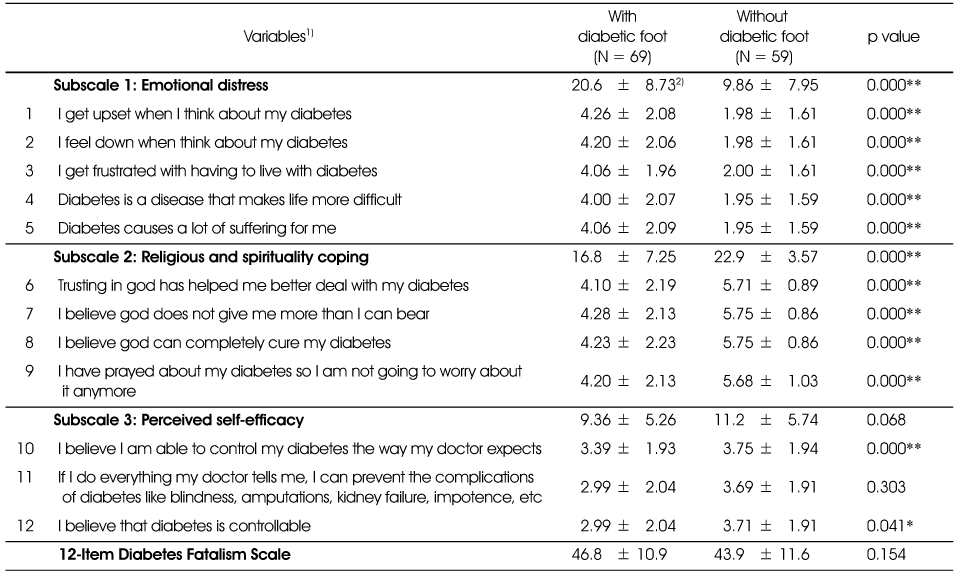References
1. Aljasem LI, Peyrot M, Wissow L, Rubin RR. The impact of barriers and self-efficacy on self-care behaviors in type 2 diabetes. Diabetes Educ 2001;27(3):393–404.
2. Bains SS, Edege LE. Associations between health literacy, diabetes knowledge, self-care behaviors, and glycemic control in a low income population with type 2 diabetes. Diabetes Technol Ther 2011;13:335–341.
3. Choi JH. Lifestyle, diet, and diabetes fatalism of patients with diabetic foot Daejin University; 2014. 7. MS thesis.
4. Chung CH, Kim DJ, Kim JY, Kim HY, Min KW, Park SW, Park JH, Baik SH, Son HS, Ahn CW, Oh JY, Lee SH, Lee JY, Choi KM, Choi IJ, Park IB. Current status of diabetic foot in Korean patients using national health insurance database. J Korean Diabetes Assoc 2006;30(5):372–376.
5. Whiting DR, Guariguata L, Weil C, Shaw J. IDF diabetes atlas: global estimates of the prevalence of diabetes for 2011 and 2030. Diabetes Res Clin Pract 2011;94(3):311–321.
6. Delamater AM, Jacobson AM, Anderson B, Cox D, Fisher L, Lustman P, Rubin R, Wysocki T. Psychosocial therapies in diabetes: report of the psychosocial therapies working group. Diabetes Care 2001;24(7):1286–1292.
7. Egede LE, Ellis C. Development and psychometric properties of the 12-item diabetes fatalism scale. J Gen Intern Med 2009;25(1):61–66.
8. Han SS, Lee SC. Nursing and Health statistical analysis Seoul: Hannarae Academy; 2012. p. 279.
9. International Diabetes Federation. IDF Diabetes Atlas 5th edth ed. Brussels, Belgium: International Diabetes Federation; 2011.
10. Jang SM, Choi KA, Yoo HJ. Alcohol drinking problems anddiabetes self-care in male diabetes. J Korean Diabetes Assoc 2004;28(2):139–148.
11. Korean Society for the Study of Obesity. WHO/IASO/IOTF: The Asia-Pacific perspective : Redefining obesity and its treatment 2000.
12. Kwon YJ, Han KA, Sung SK, Yoo HJ. A clinical study on the diabetic foot lesions. J Korean Diabetes Assoc 1989;13(1):39–45.
13. Lee JH, Chung CH. Diabetic foot: Past and present. J Korean Diabetes 2011;12(2):69–71.
14. Lee JR. Lifestyle modification and diabetes management. J Korean Diabetes 2011;12(4):215–218.
15. Lee YR, Kang MA, Kim PG. The effects of an admissioneducation program on knowledge, self-efficacy, self-care and glucose control in type 2 diabetes patients. J Korean Acad Soc Nurs Educ 2008;14(1):12–19.
16. Ministry of Health & Welfare. Korea Centers for Disease Control & Prevention. Korea Health Statistics 2011 : Korea National Health and Nutrition Examination Survey (KNHANES V-2) 2012. cited June 27, 2013. Available from
http://knhanes.cdc.go.kr/.
17. Osborn CY, Bains SS, Egede LE. Health literacy, diabtes selfcare, and glycemic control in adults with type 2 diabetes. Diabetes Technol Ther 2010;12(11):913–919.
18. Park BS, Jin GN, Choi YC, Chung JH, Koh JH, Chung CH. Self-management and health-related quality of life in adolescent and adulthood diabetic patients. J Korean Diabetes Assoc 2005;29(3):254–261.
19. Park JY, Ko IS. Development of a comprehensive selfmanagement program promoting self efficacy for type 2 diabetic patients. J Korean Acad Fundam Nurs 2012;19(1):74–86.
20. The Korean Diabetes Association. Preventive foot care in diabetes. Clin Diabetes 2005;6(3,4):192–194.
21. Toobert DJ, Hampson SE, Glasgow RE. The summary of diabetes self-care activities measure: results from 7 studies and a revised scale. Diabetes Care 2000;23(7):943–950.
22. Yoo JW. What is needed for early detection of diabetes complications? J Korean Diabetes 2013;14(1):32–35.
23. Walker RJ, Smalls BL, Hernandez-Tejada MA, Campbell JA, Davis KS, Egede LE. Effect of diabetes fatalism on medication adherence and self-care behaviors in adults with diabetes. Gen Hosp Psychiatry 2012;34(6):598–603.
24. Wycherley TP, Mohr P, Noakes M, Clifton PM, Brinkworth GD. Self-reported facilitators of, and impediments to maintenance of healthy lifestyle behaviors following a supervised research-based lifestyle intervention programme in patients with type 2 diabetes. Diabet Med 2012;29(5):632–639.




